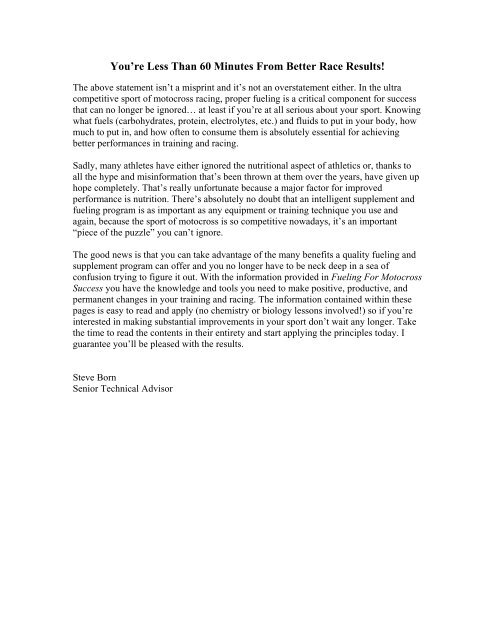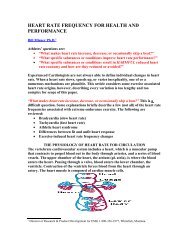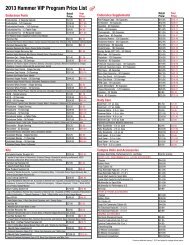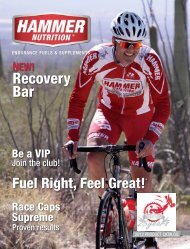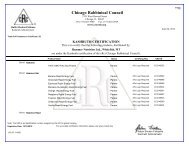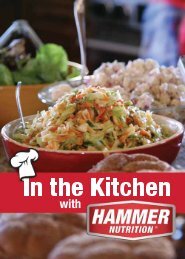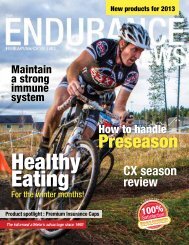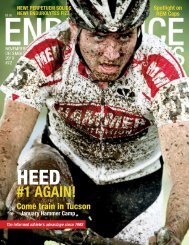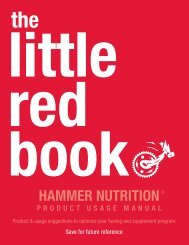Fueling For Motocross Success - Hammer Nutrition
Fueling For Motocross Success - Hammer Nutrition
Fueling For Motocross Success - Hammer Nutrition
You also want an ePaper? Increase the reach of your titles
YUMPU automatically turns print PDFs into web optimized ePapers that Google loves.
You’re Less Than 60 Minutes From Better Race Results!<br />
The above statement isn’t a misprint and it’s not an overstatement either. In the ultra<br />
competitive sport of motocross racing, proper fueling is a critical component for success<br />
that can no longer be ignored… at least if you’re at all serious about your sport. Knowing<br />
what fuels (carbohydrates, protein, electrolytes, etc.) and fluids to put in your body, how<br />
much to put in, and how often to consume them is absolutely essential for achieving<br />
better performances in training and racing.<br />
Sadly, many athletes have either ignored the nutritional aspect of athletics or, thanks to<br />
all the hype and misinformation that’s been thrown at them over the years, have given up<br />
hope completely. That’s really unfortunate because a major factor for improved<br />
performance is nutrition. There’s absolutely no doubt that an intelligent supplement and<br />
fueling program is as important as any equipment or training technique you use and<br />
again, because the sport of motocross is so competitive nowadays, it’s an important<br />
“piece of the puzzle” you can’t ignore.<br />
The good news is that you can take advantage of the many benefits a quality fueling and<br />
supplement program can offer and you no longer have to be neck deep in a sea of<br />
confusion trying to figure it out. With the information provided in <strong>Fueling</strong> <strong>For</strong> <strong>Motocross</strong><br />
<strong>Success</strong> you have the knowledge and tools you need to make positive, productive, and<br />
permanent changes in your training and racing. The information contained within these<br />
pages is easy to read and apply (no chemistry or biology lessons involved!) so if you’re<br />
interested in making substantial improvements in your sport don’t wait any longer. Take<br />
the time to read the contents in their entirety and start applying the principles today. I<br />
guarantee you’ll be pleased with the results.<br />
Steve Born<br />
Senior Technical Advisor
FUELING FOR MOTOCROSS SUCCESS<br />
Table of Contents<br />
• Eight <strong>Nutrition</strong>al Mistakes to Avoid<br />
• FUELS – What To Consume <strong>For</strong> Optimal Performance<br />
• HYDRATION – What You Need to Know<br />
• RECOVERY – Do It Right and Reap the Rewards<br />
• SUPPLEMENTATION – Your Extra Edge<br />
• <strong>Hammer</strong> <strong>Nutrition</strong> Fuels – MX Sample Starter Kit<br />
• <strong>Hammer</strong> <strong>Nutrition</strong> Fuels – MX Pro Starter Kit
FUELS – What To Consume <strong>For</strong> Optimal Performance<br />
What you put in your body in terms of fuel will greatly determine the energy you get out of it. Sounds pretty simple but<br />
that’s really the way it is. Think of it this way. When you put lower-quality/lower-grade gasoline in the tank of your<br />
motorcycle it doesn’t matter how great the engine may be, it’s just not going to run as well! The same concept is true<br />
with the body. You can have the best equipment in the world and you can train like a madman but if you don’t put the<br />
right amounts of the proper fuel in your body you’re never going to get the full value out of either of those things –<br />
equipment or training.<br />
So if you’re ready to take your training and racing to a higher level this article is really important for you because (a)<br />
it’ll explain what to avoid and why, and (b) it’ll give you the information you need regarding the <strong>Hammer</strong> <strong>Nutrition</strong><br />
fuels – <strong>Hammer</strong> Gel, HEED, Endurolytes, and Recoverite – the “premium fuels” for your body. First, let’s look at what<br />
you need to avoid…<br />
SIMPLE SUGARS – Avoid the “OSE’s”!<br />
“What are the OSE’s” you might ask. That’s the last part of the names of sugars that, if you care at all about your<br />
athletic performance and your health, you’ll avoid like the plague. The sugars I’m referring to are those 1- and 2-chain<br />
carbohydrates (a.k.a. “simple sugars”) known as glucose, sucrose, fructose, and dextrose. Avoid these as much as<br />
possible, both in your daily diet and in the fuels you consume, and you’ll be a healthier, better performing athlete.<br />
You’ve heard the phrase “garbage in, garbage out,” right Guess what—simple sugars are garbage when it comes to<br />
fueling your body during exercise and they’re downright hazardous for your health. Space limitations prevent me from<br />
going into greater detail about the health hazards of refined sugar but I highly recommend you read the article 113<br />
Ways Sugar Can Ruin Your Health, which you’ll find in the Endurance Library section of the <strong>Hammer</strong> <strong>Nutrition</strong> web<br />
site (www.e-caps.com). It’ll forever change your mind about the “innocence” of sugar.<br />
<strong>For</strong> now, let’s look at why these simple sugars should have absolutely NO part in your fuel:<br />
1.) When ingested, simple sugars cause your blood sugar levels to rise and fall dramatically. It’s a “flash and crash”<br />
type of energy that you definitely don’t want to experience unless, that is, you enjoy experiencing symptoms such as<br />
depression, malaise, and premature fatigue. <strong>For</strong> top performance you want consistent, reliable energy, not this “roller<br />
coaster,” up and down, wildly fluctuating energy.<br />
2.) When you use a fuel that contains any simple sugars it must be mixed and consumed in very weak (6-8%) solutions<br />
in order to match your body fluid chemistry and be digested with any efficiency. Now, you might think that’s not a big<br />
deal but at that weak of concentration you’re getting maybe 80-100 calories an hour, which is definitely not going to<br />
satisfy your body’s energy demands. But before you think of making a double or triple strength bottle of that sugarladen<br />
sports drink, think again. If you do that in the hopes of obtaining more calories, you’ll only end up with (at the<br />
very least) a raging case of sour stomach because you’ve made that drink too concentrated. It doesn’t come close to<br />
matching your body fluids, and it’ll literally be fermenting in your stomach. Yuck!<br />
Bottom line: Simple sugars are a very inefficient fuel source and using them to fuel your body is like trying to heat<br />
your house by burning newspapers in your stove. You get a fast heat, but it burns out quickly, and you have to<br />
continually feed the fire. Not good! Complex carbohydrates, on the other hand, are similar to putting a nice big log on<br />
the fire in that they burn longer and more evenly, with the decline in “heat” (energy levels) being much more gradual.<br />
That’s why no <strong>Hammer</strong> <strong>Nutrition</strong> fuel ever contains any added simple sugars. Avoid fuels that contain any of the<br />
“ose’s” and use complex carbohydrates only to fuel your body during exercise. Your body will thank you and your<br />
performance will be your proof.<br />
Now that you know that <strong>Hammer</strong> <strong>Nutrition</strong> fuels are the ones that will work with your body, not against it, here are the<br />
ones I think would benefit you the most:<br />
Calorie Fuels<br />
<strong>Hammer</strong> Gel – Our original fuel, an athletic mainstay for over 15 years, <strong>Hammer</strong> Gel is energy fuel in a pancake syrup<br />
consistency. You can use <strong>Hammer</strong> Gel as all or part of a pre-race meal, to fend off hunger immediately before a<br />
workout or race, and to provide all your energy needs during a workout or race. <strong>Hammer</strong> Gel can be used “as is” from<br />
the single serving pouches, “in bulk” from the <strong>Hammer</strong> Gel flask, or it can be mixed in your water bottle. Eight great<br />
tasting flavors give you plenty of variety in your fueling “menu”.<br />
HEED – HEED is <strong>Hammer</strong> <strong>Nutrition</strong>’s powdered drink mix. Unlike the majority of the drinks available to athletes,<br />
HEED isn’t loaded with any refined sugar or other garbage (artificial colors or sweeteners) that you don’t need. HEED<br />
also contains a full-spectrum electrolyte profile that will help prevent cramping. HEED comes in mandarin orange and<br />
lemon lime flavors (an unflavored version is due soon!) and all are very subtle tasting. That means that your taste buds<br />
won’t be assaulted with a too-sweet taste and you won’t have to choke it down.<br />
Either way, with <strong>Hammer</strong> Gel or HEED, you’re giving your body exactly what it needs to maintain optimal energy<br />
production from beginning to end.
Suggested Amounts by Body Weight*<br />
HAMMER GEL<br />
HEED<br />
• Up to 120 pounds: up to 2 servings/hour<br />
• 120-155 pounds: up to 2.5 servings/hour<br />
• 155-190 pounds: up to 3 servings/hour<br />
• 190+ pounds: up to 3 to 3.5 servings/hour<br />
• Up to 120 pounds: up to 1.5 scoops/hour<br />
• 120-155 pounds: up to 2.5 scoops/hour<br />
• 155-190 pounds: up to 2.75 scoops/hour<br />
• 190+ pounds: up to 3 scoops/hour<br />
*These are estimated doses. Each athlete should determine in training, under a variety of conditions, their personal<br />
optimum.<br />
Electrolytes<br />
Endurolytes – A full-spectrum, rapidly assimilated electrolyte supplement is as important to your fueling as the water<br />
you drink and the calories you eat. While the above fuels provide the calories your body needs to make energy (the<br />
body’s “gasoline”), electrolytes can be thought of as the “motor oil” for the body, providing it with the essential<br />
minerals it needs to maintain the optimal performance of many important functions, such as muscular contraction.<br />
Far too many athletes forget to replenish electrolytes consistently, or they mistake sodium or salt intake for true<br />
electrolyte replenishment. Sodium chloride (salt) is indeed an important component of electrolyte replenishment, but it<br />
does not fulfill the entire requirement. A satisfactory electrolyte replenishment product needs to include sodium,<br />
chloride, calcium, magnesium, and potassium as all these minerals play key roles in the maintenance of these important<br />
body functions. Endurolytes is that product, and you will search in vain to find another like it on the market.<br />
Unlike calorie and fluid assimilation rates, which remain fairly constant from athlete to athlete, electrolyte expenditure<br />
(and thus replenishment) varies tremendously. Body weight, level of fitness, weather conditions, acclimatization level,<br />
and biological predisposition all greatly affect electrolyte depletion and the need for replenishment. That’s why the<br />
hourly Endurolytes dose can range from 1-6 capsules an hour. That being said, a good starting dose to consider is:<br />
• Lighter weight athletes: 1-2 capsules/hour<br />
• Medium weight athletes: 2-3 capsules/hour<br />
• Larger athletes: 4-6 capsules/hour<br />
Remember though, these are only suggested starting doses and the amount you need may be different, and may vary<br />
from hour to hour.<br />
Recovery Drink<br />
Recoverite – The delicious all-in-one recovery drink with each serving (two scoops) supplying your body with 30<br />
grams of complex carbohydrates, 10 grams of whey protein isolate, and three grams of immune system-boosting<br />
glutamine. After tough training sessions or races your body is begging you to refill it with premium fuel as soon as<br />
possible. If you do that you recover faster and your immune system stays strong… it’s as simple as that. Recoverite is<br />
the super easy way to give your body exactly what it wants. Mix a couple of scoops in 12-16 ounces of cold water,<br />
drink, and you’re done. Do this after each of your workouts, even if you’re doing more than one a day. If you can’t sit<br />
down to a full meal within the next couple hours have another 2-scoop serving of Recoverite.<br />
SUMMARY<br />
What kind of food/fuel you put in your body definitely matters because it determines the kind of energy you’re going to<br />
get out of it. Nowadays, the competition is too strong and the difference between first and last is so narrow… you just<br />
can’t “wing it” and hope that you’ll get by on any old fuel. No, you have to make conscious choices in what you put in<br />
your body if you hope to get the most out of your training session and achieve success come race day. Getting your fuel<br />
dialed in is as important as any piece of equipment you use or any training techniques you employ, so definitely don’t<br />
blow it off. <strong>For</strong>tunately, <strong>Hammer</strong> <strong>Nutrition</strong> takes the guesswork out of this oft-neglected area of athletic performance<br />
by providing you with the fuels your body craves. With the <strong>Hammer</strong> fuels your pre, during, and post-workout & racing<br />
needs are perfectly and completely met. This allows you to focus on your training session or race, not on whether or not<br />
your fuel is going to let you down or make you sick.
HYDRATION – What You Need to Know<br />
I won’t go into a long dissertation about how your body’s internal cooling system works but I can tell you that it<br />
involves a variety of complex mechanisms all designed to support the body during hot weather conditions, keeping it<br />
cool and protecting the vital organs. By far, the most important part of your body’s cooling system, accounting on<br />
average for about 75% of all cooling, is your ability to produce and excrete sweat.<br />
Weather conditions greatly affect sweat production and cooling effectiveness. In cool weather, you get substantial<br />
cooling from the heat that escapes directly from your skin. As the temperature increases, you gradually rely more on<br />
evaporation. On hot days, with little difference between skin surface and ambient temperatures, your skin surface<br />
provides only negligible convective cooling, and you need to sweat more to maintain a safe internal core temperature.<br />
At 95ºF or above, you lose no heat at all from your skin; you actually start to absorb it. Evaporative cooling must do all<br />
the work.<br />
Humidity is the other major factor that affects sweat. On humid days, sweat evaporates more slowly because the<br />
atmosphere is already saturated with water vapor, which drastically slows down the evaporation rate. The sweat<br />
accumulates on your skin and soaks your clothes, but you don’t get any cooling from it because it’s not evaporating.<br />
Soaking, dripping sweat may give you a psychological boost, but it has no physical efficacy to cool; sweat must<br />
evaporate to remove heat. On days when it’s both hot and humid Well, you don’t need to read about what’s going to<br />
happen when you exercise in those conditions. You do need to know that under the worst of conditions you can<br />
produce up to three liters of sweat in an hour of strenuous exercise, but your body can only absorb about one liter from<br />
fluid consumption. Yes, this will cause problems before long, and we will discuss that issue below.<br />
What Happens When the Coolant Runs Low<br />
Just like a car, your body must dissipate the excess heat generated from burning fuel. However, unlike an automobile,<br />
your body’s coolant isn’t in a sealed internal system; you use it once and then it’s gone and needs to be replaced.<br />
Unfortunately, we don’t come with built-in gauges or indicators that tell us just how much coolant we have left in our<br />
system. We can’t run a dipstick down our gullet and get a reading that says, "Add a quart." We do have some<br />
physiological signs, but they function at the “Warning-Danger!” level, too late to maintain optimal performance. <strong>For</strong><br />
instance, by the time you feel thirsty, you could have a 2% body-weight water loss, already into the impairment zone.<br />
The chart below shows what happens to human performance at each percent of weight loss. By weight loss, we mean<br />
the percentage of your body weight at the start of exercise that you have lost via sweat. If you go out for a ride at 160<br />
pounds and weigh in a few hours later at 154, you’ve lost almost 4% of your body weight.<br />
Symptoms by Percent Body Weight Water Loss:<br />
PERCENT WATER LOST --------- SYMPTOMS<br />
0% --- none, optimal performance, normal heat regulation<br />
1% --- thirst stimulated, heat regulation during exercise altered, performance declines<br />
2% --- further decrease in heat regulation, hinders performance, increased thirst<br />
3% --- more of the same (worsening performance)<br />
4% --- exercise performance cut by 20 - 30%<br />
5% --- headache, irritability, "spaced-out" feeling, fatigue<br />
6% --- weakness, severe loss of thermoregulation<br />
7% --- collapse likely unless exercise stops<br />
10% -- comatose<br />
11% -- death likely<br />
[<strong>Nutrition</strong> for Cyclists, Grandjean & Ruud, Clinics in Sports Med. Vol 13(1);235-246. Jan 1994]<br />
Over-hydration – Too Much Of A Good Thing<br />
So now you’re probably thinking, “Whoa, I’ve got to drink a lot of fluid!” Well, that’s true to some extent but while not<br />
drinking enough fluids (dehydrating) can cause some problems, drinking too much (over-hydrating) can cause just as<br />
many problems, perhaps more, some with devastating consequences.<br />
In the past several months there have been a lot of articles written about the dangers associated with over-hydration,<br />
which again, is simply drinking more fluids than your body can handle. In fact, there have been numerous athletes<br />
(runners, mostly) who drank so much fluid in hot weather that they ended up in the hospital. Some have even died (yep,<br />
died!) and it’s all due to over-hydration. With that in mind, we all know that racing motocross in the heat is more<br />
challenging than in other sports like marathon running. You don’t have the luxury of being able to race in a tank top,<br />
shorts and running shoes the way runners do. With all of your riding gear and helmet, staying hydrated and avoiding<br />
overheating is very difficult. So what do you do<br />
Well, most of the advise you’ve heard before about hydrating in the heat probably sounded something like this: “drink,<br />
drink and drink some more” or “drink even when you’re not thirsty” or “drink to replace” – <strong>For</strong>get all of this, it’s just<br />
plain wrong. Although well intentioned, this advice is inaccurate at best and can be downright dangerous at worst. At<br />
the races, over-hydration and the electrolyte depletion that goes with it causes you to feel tired, lethargic, queasy, and<br />
experience muscle cramps and many other symptoms that many have inaccurately been thought to be caused by<br />
dehydration. So needless to say, you have to be very conscientious about how much fluid you consume since too much<br />
is just as bad or worse as too little.<br />
Regardless of how hot it is, even when the heat index is well over 100, you must resist the urge to drink excessive<br />
amounts. The majority of athletes under most conditions will satisfy their hydration needs with a fluid intake in the 20-
28-ounce per hour range (roughly the size of the typical small to large water bottle. We’ve provided a weight-adjusted<br />
chart below that will provide a gauge as to the maximal amounts of fluids you can consider consuming hourly. Keep in<br />
mind though, that these are suggested maximal amounts and that your requirements may be less. <strong>For</strong> most athletes,<br />
fluid intake over 30 ounces hourly really increases the potential for serious performance and health problems. Keep that<br />
in mind before you gulp down excessive amounts of fluid. If you override your internal mechanisms, you’ll find out the<br />
hard way how your body deals with excess water intake during intense exercise.<br />
Tips <strong>For</strong> Proper Hydration And Top Performance In The Heat<br />
• Treat each moto as a 1-hour exercise period, even though it may only last 15-20 minutes – Sip 10-28 ounces<br />
of HEED or water after each moto. See chart below.<br />
• To cool off (which helps lower your core temperature) take a wet towel out of the ice chest and put it over<br />
your head and shoulders. If you have enough time between motos, strip out of your gear and jump in the<br />
creek or sit in the shade with your wet towel.<br />
• Avoid foods and fuels that contain simple sugars (glucose, fructose, dextrose, sucrose) as they require more<br />
fluids and electrolytes for digestive purposes. Also avoid carbonated drinks, as the gas inhibits absorption.<br />
• Use caffeine with caution. Used properly and sparingly, caffeine has some benefits. It does, however, also act<br />
as a diuretic, which may deplete fluid stores more rapidly.<br />
• Take Endurolytes, which will supply the important electrolytic minerals your body needs to function<br />
optimally and to prevent cramping.<br />
• Know the symptoms of over-hydration and dehydration. Stop immediately if you feel lightheaded, queasy, or<br />
get the dry chills. No race or training is worth compromising your health.<br />
Maximal Fluid Intake Chart<br />
Weight in pounds max fluid ounces per hour<br />
60 10-12<br />
80 13-15<br />
100 16-18<br />
120 20-22<br />
140 23-24<br />
150 25-27<br />
165 28-30<br />
180 30-32<br />
200 33-36<br />
SUMMARY<br />
Water is the most important component of your fueling regimen, more than any fuel or supplement. It comprises 60%<br />
of your body weight, and should be the number one concern on your intake list. Dehydration and/or over-hydration is a<br />
common problem that plagues far too many athletes, some with severe consequences. Armed with the guidelines<br />
contained in this article, along with practice and testing in training, your performance and health need not suffer.<br />
Instead, you’ll be ahead of the vast majority of athletes who continue to make the same mistakes over and over again.
RECOVERY – Do It Right and Reap the Rewards<br />
Most of the time the first thing we want to do after a tough workout is get out of our dirty, sweaty workout gear and<br />
take a shower. After that, the next thing we usually end up doing is heading straight for the couch for some well-earned<br />
R&R. Does that scenario sound familiar to you too If so, you’re not alone but in all honesty it’s not the best thing you<br />
can do to get the most out of your workouts and “prep” your body for your upcoming races. In fact, I believe that one<br />
of the areas that athletes tend to neglect the most is in regards to recovery, specifically the refueling of the body as soon<br />
as possible after each and every workout.<br />
Are you guilty of this as well If so, that’s really unfortunate because it’s absolutely one of the most important things<br />
that you can do to improve your chances of success come race day. In fact, I honestly believe that properly refueling<br />
your body immediately after all your training sessions is as important as anything you did in the actual workout. When<br />
you give your body what it needs as soon as possible after exercise (and that means before hitting the shower and<br />
before getting horizontal on the sofa) it will respond wonderfully and you’ll benefit tremendously. You recover and<br />
rebuild faster, and your body is able to store more and more of a premium, ready-to-use fuel known as muscle<br />
glycogen. The bottom line is that you can really give yourself a major advantage come race day if you’ll take the time<br />
to put some quality fuel back in your body as soon as possible after all your workouts leading up to the race.<br />
If you’re at all serious about performing better in your racing AND staying healthier, here’s a saying you need to live<br />
by – “Once you’ve finished training, you’re still not finished training!” Here’s what I mean: You’ve got to pay as<br />
much attention to recovery as you do to your workout if you expect to reap the benefits of hard training. In other words,<br />
how well you recover today will be a huge factor in how well you perform tomorrow.<br />
And you know what It’s really simple to maximize your recovery and reap all the rewards that come from that. Here<br />
are the two primary things you need to do:<br />
1.) Consume 30-60 grams of quality carbohydrates within the first 30 minutes after each workout<br />
2.) Consume 10-30 grams protein, preferably whey protein, during that time as well<br />
Let’s take a brief look at each of those components, beginning with carbohydrate replenishment. When you begin a<br />
workout or race the first fuel your body will use is stored carbohydrate, which is known as muscle glycogen. There is a<br />
finite amount of this premium fuel available in your body but its importance can’t be overstated. Quite simply, the<br />
athlete who has more of this readily available fuel in their body has a definite advantage and to have a good race or<br />
workout, you need to start with a full load of muscle-stored glycogen.<br />
The question is: How can you get your body to store as much of it as it possibly can The first way is through training,<br />
which increases both muscle glycogen storage capacity and how efficiently your body uses it. The second way is to<br />
replenish the body with carbohydrates as soon as possible after exercise, which is when the body is most receptive to<br />
taking those carbs, converting them into glycogen, and storing them in the muscles. Along with insulin, an enzyme<br />
known as glycogen synthase drives carbohydrates into glycogen stores and protein into muscle cells. Unfortunately, the<br />
“life span” of glycogen synthase is relatively short, peaking in the 0-30 minutes after exercise then declining<br />
substantially for the next 90 minutes. Needless to say, to store as much glycogen as possible, it’s important to take<br />
advantage of the glycogen synthase enzyme when it’s most active.<br />
Here’s why all this is so important to you as an athlete:<br />
1. The less-fit athlete, and the one who HAS NOT been putting carbohydrates back in their body shortly after<br />
exercise, has very limited amounts of muscle glycogen available, perhaps as little as 10-15 minutes worth.<br />
2. The fit athlete, and the one who HAS been consistently refueling their body with carbohydrates immediately<br />
after exercise, can build up a nice 60-90 minute reservoir of this premium, ready-to-use fuel. Which would<br />
you rather have when the gate drops – a measly 15 minutes of on-board, ready-to-use fuel or a full 90<br />
minutes worth The answer should be pretty obvious.<br />
RULE #1 – As soon as possible after you finish your workout, before you get into the<br />
shower or before you get horizontal, consume approximately 30-60 grams of high quality<br />
complex carbohydrates.<br />
Now let’s look at protein. You see, while carbohydrate intake promotes many aspects of post-exercise recovery, it can’t<br />
do the job alone; you need protein as well. The primary reason for consuming protein is that it provides the raw<br />
materials needed to rebuild stressed muscles. Protein also plays a key role in how well the body stores glycogen.<br />
Finally, protein is crucial for maintaining a strong immune system.<br />
Of all the protein sources available whey protein is considered the ideal protein for recovery. It’s the fastest acting<br />
protein source and contains the highest percentage of essential amino acids, the protein “building blocks” that your<br />
body does not manufacture and must obtain from dietary sources. Whey protein is also rich in other amino acids that<br />
have a direct impact on strengthening your immune system.<br />
So for rebuilding the muscle tissue, for maximizing how much glycogen your body can store, and to build a strong<br />
immune system don’t forget to consume protein, preferably whey protein, after your workouts.
RULE #2 – After your workouts, consume 10-30 grams of protein, preferably whey, along<br />
with your complex carbohydrates.<br />
You can use high quality solid food to refuel your body after your workouts. Whole grain breads, pasta, fruits, and<br />
cereal are all good carbohydrate choices. <strong>For</strong> protein, you can eat most any kind of meat – chicken, beef, fish – as well<br />
as cheese and eggs. Just as an example, a PB&J sandwich – using organic bread, organic fruit spread, and healthy<br />
peanut butter (the kind where the oil floats on top of the jar) – is a pretty darn good post-workout recovery meal. A<br />
bagel, a piece of fruit, and a serving of cottage cheese is another good post-workout meal choice.<br />
If you’re unable or uninterested in making a full-fledged meal after your workout, consider using Recoverite, a<br />
delicious and easy to make carb/protein powdered drink mix. Recoverite contains an ideal 3:1 ratio of quality complex<br />
carbohydrates and whey protein so it takes the guesswork out of post-workout recovery. Mix a couple of scoops with<br />
water, drink, you’re done… simple. You’ve just put the best “finishing touches” on your workout that you possibly<br />
could, and you’ve given your body a great head start on tomorrow’s workout.<br />
SUMMARY<br />
Athletic performance improvement depends on successive, incremental exercise sessions that stimulate muscular and<br />
cardiovascular adaptation followed by a recovery period in which the body rebuilds itself slightly more fit than before.<br />
Thus, the real gain of exercise occurs during recovery, but only in the presence of adequate rest and optimal<br />
nutritional support. Remember, how well you recover today will greatly determine your performance tomorrow.<br />
Athletes who attend to the recovery process as much as they do to active training are way ahead of the game and will<br />
no doubt enjoy increased performance.
SUPPLEMENTATION – Your Extra Edge<br />
Supplements aren’t thought about too often with athletes and I think there are two reasons for that. First, athletes are<br />
mistakenly told that “you can obtain all the nutrients from your diet.” Second, most athletes are simply overwhelmed<br />
by the tremendous number of products out there and the equally tremendous amount of hype.<br />
Here are my answers to both of those points:<br />
1.) If you’re a competitive athlete or even just a fairly active person, your diet, no matter how good you think it<br />
might be, is simply not going to provide you with enough of the vitamins and minerals your body needs for<br />
the optimal performance of literally hundreds of important functions. Dr. Bill Misner states, "Athletes today<br />
ingest only 11% of the organic nutrients from their food sources that the athletes of the 1940’s enjoyed.” That<br />
means exactly what you think it does: Due to a variety of factors (farming techniques, the use of commercial<br />
fertilizers, pesticides, herbicides, commercial ripening, harvesting, shipping, storing, and processing<br />
practices) the food you’re eating most likely has very minimal amounts of nutrients left in them.<br />
Also, you’ve heard of the Recommended Daily Allowance (RDA), right Well, I believe that standard is very<br />
much outdated and is one that never took into account the particular needs of athletes in the first place. My<br />
belief is confirmed from one well-known sports nutritionist who states, " If you use the RDAs to plan your<br />
nutrition, you will never, never reach your athletic potential."<br />
Bottom line: It’s a well-accepted truth that athletes use up more nutrients than couch potatoes do. In other words, the<br />
more active you are, the more nutrients (vitamins, minerals, enzymes, co-enzymes, etc) you’re going through.<br />
Unfortunately, our food supply just doesn’t contain what it used to. And if these nutrients aren’t in the soil, they’re not<br />
in the foods and if they’re not in the foods, they’re not in your body. So while it’s important to eat as healthy as<br />
possible (you know the drill – lots of fresh fruits and vegetables, etc) your diet’s not going to take care of all your<br />
needs.<br />
2.) Yes, the supplement industry can sometimes be very difficult for a consumer to figure out. Just as an<br />
example, walk into any health food store and you’ll be overwhelmed with the number of products available to<br />
athletes. Then, check out most of these company’s web sites and you’ll be blown away by the hype that<br />
surrounds their products (“pack on 10 lbs of lean muscle mass in days!” and other similar nonsense). Look,<br />
there’s no doubt that supplementation is really important if you’re at all interested in improving your athletic<br />
performance and health. You just need to get past the hype and empty promises that come with all of the<br />
“here today, gone tomorrow” companies and utilize products that come from companies with a solid<br />
reputation and a long history of good ethics. And that’s where we at <strong>Hammer</strong> <strong>Nutrition</strong> can help.<br />
Bottom line: An intelligent supplement program can yield tremendous benefits for you. Your performance on the bike<br />
and your overall health can be greatly improved by the consistent use of the right supplements. When you use any of<br />
the E-CAPS supplements you’re going with a company that has a sterling reputation in the industry and one where you<br />
can have complete confidence. We guarantee that you will notice a substantial difference when you use our products.<br />
That’s right, guaranteed.<br />
SUPPLEMENT SELECTION<br />
OK, so now you’re thinking that taking supplements is a good idea. Which ones to use though Well, the E-CAPS<br />
product line consists of over a dozen different supplements but I’ve boiled it down to a mere two. That’s right, I believe<br />
that there are two supplements that, if you’ll take them consistently, will make a major difference in both your<br />
performance in training and racing, and in your general health as well. These are the two products that I believe provide<br />
the widest range of benefits for you, helping you to get the very most out of every minute you put into your training<br />
while also protecting and strengthening your immune system. And both are really important. Yes, you want to have an<br />
edge on your opponents come race day and both products will help you achieve that. But they’re also vital for your<br />
general health, which you should be very much interested in. You see, if you’re sick you can’t train, and if you can’t<br />
train you can’t improve. And not improving means you’re going to be left behind, taking in someone else’s dust instead<br />
of vice versa. However, with these two products you’ll have what you need to help maintain a strong immune system,<br />
which will definitely make a difference in all your workouts and races.<br />
The first product is called Premium Insurance Caps and this is your multivitamin/mineral supplement, the product<br />
that will cover your basic nutrient needs. Remember, you’re going to be depleting your body of nutrients at a much<br />
higher rate than sedentary people do, which is why this product is so perfect. It contains optimal amounts of vitamins,<br />
minerals, enzymes, and healthy “super foods,” levels you won’t find in the typical store-bought vitamin. Premium<br />
Insurance Caps doesn’t replace your efforts in eating healthy but it definitely “bridges the gap” between what you<br />
should be obtaining in your diet versus what you’re actually getting.<br />
SUGGESTED DOSE<br />
Workout Days: Take a full packet (7 capsules) in divided doses, with 4 of those capsules being consumed with your<br />
post-workout meal.<br />
Days Off: Take 2 capsules with breakfast, 2 with lunch or dinner.<br />
Race Day: Take 3 capsules with breakfast, 4 capsules after your last moto, with food.<br />
*************************************
The second product is called Race Caps Supreme. Think of this product as your body’s spark plugs, the nutrients that<br />
are necessary to convert your food and oxygen into energy. When you take Race Caps Supreme you’ll be providing<br />
your body with the specific nutrients that will increase your endurance. You won’t be doing it “artificially” with<br />
stimulants, but with the key subtrates (“spark plugs”) that your body needs to make energy more consistently and<br />
efficiently. In addition, the primary nutrients in Race Caps Supreme are also excellent antioxidants, which will work<br />
perfectly with Premium Insurance Caps in protecting your immune system. This product has been a staple in the<br />
supplement regimen of thousands of athletes for nearly two decades and when you take it consistently you’ll notice the<br />
following:<br />
• You won’t be as sore and tired from your workouts<br />
• You’ll have more energy during the day<br />
• You’ll be able to increase the workload and intensity of your workouts<br />
• You’ll notice your muscles performing better, with much less burning than before<br />
• You’ll recover from your workouts faster<br />
SUGGESTED DOSE<br />
Workout Days: Take 1 capsule before your workout and 1 capsule afterwards. If you’re going to be training for more<br />
than two hours, double the dose (2 before, 2 after). On days off take 1 capsule with breakfast and 1 with lunch.<br />
Days Off: Take 1 capsule with breakfast, 1 with lunch<br />
Race Day: Take 2 capsules 30-45 minutes before each moto. Take 2 capsules after your last moto, with food.<br />
SUMMARY<br />
Supplements are just that… they supplement a good diet and provide ideal amounts of important nutrients that you<br />
can’t obtain even in the best of diets. Remember, supplements don’t replace a good diet, nor are they a substitute for<br />
consistent, high quality training and adequate recovery. You need to make sure those two things – a good diet and a<br />
quality training/recovery plan – are already in place. When they are, supplements can definitely help take your<br />
performance to the next level, allowing you to make increases in the volume and quality of your training, without your<br />
immune system taking such a hit. Translated, that means better performance come race day and better overall health.
<strong>Hammer</strong> <strong>Nutrition</strong> Fuels - MX Sample Starter Kit<br />
<strong>For</strong> your training sessions and races you need three things – fluids (to keep you hydrated), calories (for energy production<br />
during your workouts and for recovery after your workouts), and electrolytes (to prevent cramping and optimize many<br />
important body functions). You provide the water; we’ll take care of the rest. <strong>Hammer</strong> Gel and/or HEED are your “during<br />
exercise” calorie fuels, Endurolytes will take care of your electrolyte requirements, and Recoverite will fulfill your body’s<br />
recovery needs.<br />
FOR WORKOUTS – 90 minutes or less<br />
Use one of the following two options:<br />
• 15-30 minutes prior to workout – Take 1-3 Endurolytes (lean towards the higher amount if the weather is hot)<br />
• 15-30 minutes prior to workout – Consume 1 serving of <strong>Hammer</strong> Gel with water<br />
• During workout – Drink 20-28 ounces of water hourly<br />
OR:<br />
• 15-30 minutes prior to workout – Take 1 Endurolytes<br />
• During workout – Consume 1-2 scoops of HEED mixed in 20-28 ounces of water<br />
After Workouts<br />
• 2 scoops of Recoverite mixed in 12-16 ounces of water. Drink immediately after completing workout session.<br />
----------------------------------------------------------------------------------------------------------------------------------------<br />
FOR WORKOUTS - 90 minutes or longer<br />
Use one of the following two options:<br />
• 15-30 minutes prior to workout – Take 1-3 Endurolytes<br />
• 15-30 minutes prior to workout – Consume 1 serving of <strong>Hammer</strong> Gel with water<br />
• During workout – Consume 1-3 servings of <strong>Hammer</strong> Gel per hour – See chart below for dosage suggestions<br />
• During workout – Drink 20-28 ounces of water hourly<br />
OR:<br />
• 15-30 minutes prior to workout - Take 1-2 Endurolytes<br />
• During workout – Consume 1-3 scoops of HEED mixed in 20-28 ounces of water every hour – See chart below for<br />
dosage suggestions<br />
After Workouts<br />
• 2-4 scoops of Recoverite in 12-16 ounces of water. Drink immediately after completing workout session.<br />
---------------------------------------------------------------------------------------------------------------------------------<br />
RACE DAY FUELING PLAN<br />
OPTION ONE: Consume a light breakfast (200-400 calories) 3+ hours prior to start of first moto. Take 1-3<br />
Endurolytes with breakfast.<br />
OPTION TWO: If you have a very early race start, skip breakfast (it’s OK… really!) and take 2 servings of <strong>Hammer</strong><br />
Gel + 1-3 Endurolytes 5-15 minutes prior to first moto.<br />
If you have LESS than 60 minutes between motos –<br />
• Take 1-6 Endurolytes (use appropriate amount for your size and weather conditions – see chart below) with water<br />
immediately after each moto<br />
• Consume 1-3 servings of <strong>Hammer</strong> Gel (see chart below) between each moto<br />
• Drink 10-28 ounces of water between each moto<br />
If you have MORE than 60 minutes between motos –<br />
• 1-3 scoops of HEED (see chart below) mixed in 12-28 ounces of water. Drink a bottle every hour.<br />
• If it’s extremely hot take 1-6 Endurolytes (see chart below) with HEED immediately after each moto. Repeat<br />
hourly.<br />
Post-Race <strong>Fueling</strong><br />
• 2-4 scoops of Recoverite in 16-24 ounces of cold water. Start drinking immediately after completing race.<br />
--------------------------------------------------------------------------------------------------------------------------------------------------<br />
USAGE CHART – Dosage Suggestions By Weight or Size<br />
<strong>Hammer</strong> Gel<br />
HEED<br />
Up to 120 pounds: up to 2 servings/hour<br />
Up to 120 pounds: up to 1.5 scoops/hour<br />
120-155 pounds: up to 2.5 servings/hour 120-155 pounds: up to 2.5 scoops/hour<br />
155-190 pounds: up to 3 servings/hour 155-190 pounds: up to 2.75 scoops/hour<br />
190+ pounds: up to 3 to 3.5 servings/hour 190+ pounds: up to 3 scoops/hour<br />
Endurolytes<br />
Lighter athletes: 1-2 capsules/hour Medium weight athletes: 2-3 capsules/hour Larger athletes: 4-6 capsules/hour
<strong>Hammer</strong> <strong>Nutrition</strong> Fuels & E-CAPS Supplements - MX Pro Starter Kit<br />
FOR WORKOUTS – 90 minutes or less<br />
Use one of the following two options:<br />
• 30-60 minutes prior to workouts – Take 1 Race Caps Supreme<br />
• 15-30 minutes prior to workout – Take 1-3 Endurolytes (lean towards the higher amount if the weather is hot)<br />
• 15-30 minutes prior to workout – Consume 1 serving of <strong>Hammer</strong> Gel with water<br />
• During workout – Drink 20-28 ounces of water hourly<br />
OR:<br />
• 30-60 minutes prior to workouts – Take 1 Race Caps Supreme<br />
• 15-30 minutes prior to workout – Take 1 Endurolytes<br />
• During workout – Consume 1-2 scoops of HEED mixed in 20-28 ounces of water<br />
After Workouts<br />
• 2 scoops of Recoverite mixed in 12-16 ounces of water. Drink immediately after completing workout session.<br />
• Take 1 Race Caps Supreme with your Recoverite<br />
• Take 2 Premium Insurance Caps (from the packet of 7) with your Recoverite. Take another 2 capsules later in the<br />
day with food – Total of 4 capsules<br />
----------------------------------------------------------------------------------------------------------------------------------------<br />
FOR WORKOUTS - 90 minutes or longer<br />
Use one of the following two options:<br />
• 30-60 minutes prior to workouts – Take 2 Race Caps Supreme<br />
• 15-30 minutes prior to workout – Take 1-3 Endurolytes<br />
• 15-30 minutes prior to workout – Consume 1 serving of <strong>Hammer</strong> Gel with water<br />
• During workout – Consume 1-3 servings of <strong>Hammer</strong> Gel per hour – See chart below for dosage suggestions<br />
• During workout – Drink 20-28 ounces of water hourly<br />
OR:<br />
• 30-60 minutes prior to workouts – Take 2 Race Caps Supreme<br />
• 15-30 minutes prior to workout - Take 1-2 Endurolytes<br />
• During workout – Consume 1-3 scoops of HEED mixed in 20-28 ounces of water every hour – See chart below for<br />
dosage suggestions<br />
•<br />
After Workouts<br />
• 2 scoops of Recoverite in 12-16 ounces of water. Drink immediately after completing workout session.<br />
• Take 1 Race Caps Supreme with your Recoverite<br />
• Take 4 Premium Insurance Caps (from the packet of 7) with your Recoverite. Take the other 3 capsules later in the<br />
day with food.<br />
---------------------------------------------------------------------------------------------------------------------------------<br />
RACE DAY FUELING PLAN<br />
OPTION ONE: Consume a light breakfast (200-400 calories) 3+ hours prior to start of first moto. Take 2 Race<br />
Caps Supreme + 3 Premium Insurance Caps with breakfast.<br />
OPTION TWO: If you have a very early race start, skip breakfast (it’s OK… really!) and take 2 servings of<br />
<strong>Hammer</strong> Gel + 1-3 Endurolytes + 2 Race Caps Supreme 5-15 minutes prior to first moto.<br />
If you have LESS than 60 minutes between motos –<br />
• Take 1 Race Caps Supreme after each moto<br />
• Take 1-6 Endurolytes (use appropriate amount for your size and weather conditions – see chart below) with water<br />
immediately after each moto<br />
• Consume 1-3 servings of <strong>Hammer</strong> Gel (see chart below) between each moto<br />
• Drink 10-28 ounces of water between each moto<br />
If you have MORE than 60 minutes between motos –<br />
• Take 1 Race Caps Supreme after each moto<br />
• 1-3 scoops of HEED (see chart below) mixed in 12-28 ounces of water. Drink a bottle every hour.<br />
• If it’s extremely hot take 1-6 Endurolytes (see chart below) with HEED immediately after each moto. Repeat<br />
hourly.<br />
Post-Race <strong>Fueling</strong><br />
• 2-4 scoops of Recoverite in 16-24 ounces of cold water. Start drinking immediately after race<br />
• Take 2 Race Caps Supreme with your Recoverite<br />
• Take 4 Premium Insurance Caps (from the packet of 7) with your Recoverite<br />
--------------------------------------------------------------------------------------------------------------------------------------------------<br />
USAGE CHART – Dosage Suggestions By Weight or Size<br />
<strong>Hammer</strong> Gel<br />
HEED<br />
Up to 120 pounds: up to 2 servings/hour<br />
Up to 120 pounds: up to 1.5 scoops/hour<br />
120-155 pounds: up to 2.5 servings/hour 120-155 pounds: up to 2.5 scoops/hour<br />
155-190 pounds: up to 3 servings/hour 155-190 pounds: up to 2.75 scoops/hour<br />
190+ pounds: up to 3 to 3.5 servings/hour 190+ pounds: up to 3 scoops/hour<br />
Endurolytes<br />
Lighter athletes: 1-2 capsules/hour Medium weight athletes: 2-3 capsules/hour Larger athletes: 4-6 capsules/hour


